
Pimpri-Chinchwad also known as "PCMC", is a city in the Indian state of Maharashtra. The city is about 15 km (9.3 mi) northwest of the historic city of Pune, at an altitude of 590 m (1,940 ft) above sea level. It is the fifth largest city in Maharashtra and the nineteenth largest city in India and the sixteenth largest satellite city in the world by population. The city is located 135 km (84 mi) southeast from the state's capital Mumbai. It is one of the most rapidly developing suburban areas in India and has emerged as the third fastest growing city in the country. It is well known for its automotive, IT and manufacturing industry.
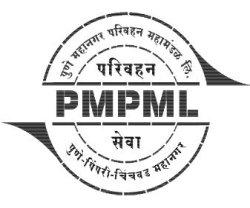
Pune Mahanagar Parivahan Mahamandal Ltd (PMPML) is the public transport bus service provider for the city of Pune, India.
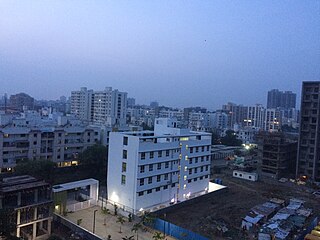
Hadapsar is a developed town in eastern Pune City, Maharashtra, India. After 1990, Hadapsar developed into a major industrial area and is now one of the most densely populated and developed areas of Pune District. It is well connected to all parts of city. Distances to popular city centers is: Pune Railway Station 8 km, Lohegaon Airport 8 km, Koregaon Park 5 km, Swargate Bus Stand 7 km and Shivaji Nagar Railway Station 12 km.

Hinjawadi is a suburb in Pimpri Chinchwad on the outskirts of Pune, India. It houses the Rajiv Gandhi Infotech Park, a large tech and business park spread over 2,800 acres, which was built by the Maharashtra Industrial Development Corporation. The IT Park is home to over 800 IT companies of all sizes.
Warje is a suburb of Pune, in the Indian state of Maharashtra.

Pune Metro is a mass rapid transit system serving the city of Pune, India. The system comprises 3 lines with a combined length of 54.14 km (33.64 mi), of which 24.12 km (14.99 mi) on two lines are operational as of August 2023. The extended metro line from Ruby Hall Clinic to Ramwadi, including the Bund Garden, Kalyani Nagar and Ramwadi metro stations, covering a distance of 6 km, was inaugrated on 6 March 2024. The 16.59 km (10.31 mi) Purple Line from PCMC Bhavan to Swargate runs on an elevated viaduct between PCMC Bhavan to Range Hills, from where it goes underground. The Aqua Line runs from Vanaz to Ramwadi covering a distance of 14.66 km (9.11 mi) on an elevated viaduct. The 23.33 km (14.50 mi) elevated Line 3 will run from the Rajiv Gandhi Infotech Park in Hinjawadi via Balewadi to Civil Court. All three lines will align at the Civil Court interchange station.

Swargate is an area of Pune, Maharashtra, India. This is one of the busiest areas in Pune. The Swargate connects Pune to various areas like Hadapsar, Fursungi, Dhankawadi, Bibwewadi, etc. The areas under Swargate include Guru Nanak Nagar, Mukund Nagar, and Municipal Colony. The old city of Pune ends here.
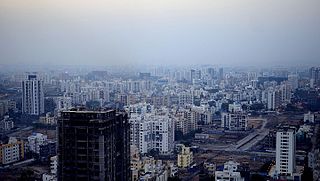
Balewadi is a residential suburban town of Pune, located in the city's Western Metropolitan Corridor. It is famous for the Shree Shiv Chhatrapati Sports Complex which had hosted both the National Games in 1994 and the 2008 Commonwealth Youth Games. The complex had also hosted the second edition of Khelo India Youth Games, which kicked off on 9 January 2019.
Nigdi is an affluent suburb in the city of Pune, India. Bhakti Shakti, Nigdi is considered as the gateway to Pune. Nigdi Pradhikaran is also an important administration locality for industrial area Pimpri-Chinchwad. Nigdi is a well developed locality with property rates being high in and around Bhakti Shakti and in Pradhikaran localities. Nigdi is also home to Pimpri Chinchwad New Town Development Authority, GST bhavan, Kendriya Sadan - Pune CBI headquarters and many more. Nigdi is near to Akurdi, Dehu road and Chinchwad railway station. There is a bus terminal at Bhakti Shakti, Nigdi where you get buses to every corner of the city. Luxury travels and State Transport buses are also easily available in Nigdi.
Swargate bus station consists of two adjacent bus stations in Pune, operated by the Maharashtra State Road Transport Corporation (MSRTC) and the Pune Mahanagar Parivahan Mahamandal Limited (PMPML). It is located in the locality of Swargate in Pune, opposite the Swargate Police Station.
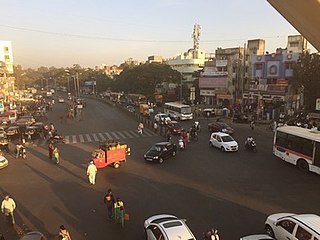
Vishrantwadi is a suburb of Pune City in the State of Maharashtra, India. Vishrantwadi is a bustling commercial and residential neighborhood to the north of the city and includes the areas of Mohanwadi, Pratik Nagar, Kasturbawadi, Phule Nagar, Mental Corner, Police Lines, Shanti Nagar, Dhanori, Tingre Nagar, Kalas, Mhaskewasti and Dighi.

Pimple Saudagar is an upscale neighbourhood in the city of Pune, India. Situated 6 kilometres (3.7 mi) from Chinchwad and closeby to prominent suburbs of Baner, Wakad, and Aundh, the locality is a progressive residential area that attracts the newer population of the city.
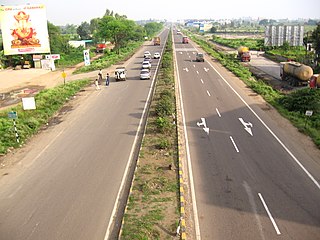
Wakad is a neighbourhood in the city of Pimpri-Chinchwad, India. Given its close proximity to Rajiv Gandhi Infotech Park in Hinjawadi, Wakad has recently emerged to be a popular neighbourhood for techies and expats. It is very diverse and cosmopolitan.
Pimple Gurav is a neighbourhood situated on the banks of River Pavana in the city of Pune, India.
Shikrapur is a panchayat village in the state of Maharashtra, India. It is the urban growth centre of PMRDA and largest village in the Shirur Taluka of Pune District in Maharashtra.
Dhayari is a suburb of Pune, Maharashtra, India,
Pune is a city in the state of Maharashtra in India. It is situated in western Maharashtra on the Deccan Plateau. Pune's public transport consists primarily of a bus service, a suburban rail service, metro, public taxis and auto rickshaws. In 2020 it was awarded the Sustainable Transport Award.
Rahatani is a suburb of Pimpri-Chinchwad situated on the banks of the Pavana in Pune district. Rahatani is 7 kilometres (4.3 mi) from Hinjawadi and centered in between the suburbs of Pimple Saudagar and Kalewadi.
Thergaon is a suburb of the city of Pimpri-Chinchwad, [Pune]India.

Ravet is a neighbourhood in the city of Pune, Maharashtra, India. It is located within Pimpri Chinchwad. The Pavana river helps form the southern border of the neighbourhood.























